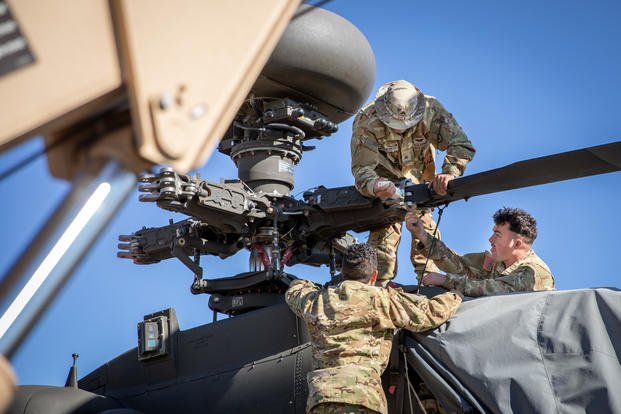Series: Military Readiness Reform – Part I: The Right to Repair
A Push to Give Troops More Control Over Their Gear
For years, service members have been limited in what they can fix, even when they know how. A broken part often meant waiting for a contractor or shipping an entire system back home for repair.
That may soon change. A provision in the Fiscal Year 2026 National Defense Authorization Act (NDAA) would give the Pentagon new authority to let troops and maintainers perform approved repairs using manuals, tools, and digital parts libraries that are often locked behind manufacturer agreements.
Advocates describe it as one of the most practical readiness reforms in decades, with broad bipartisan support.
Why Readiness Depends on Repair Access
In written responses to questions from Military.com, Dr. Guido Rossi, a research fellow at the Global and National Security Institute at the University of South Florida, said the issue is directly tied to readiness.
“The inability to quickly repair systems in the field is extremely detrimental to operational readiness,” Rossi said. “In wartime, delays that could be solved with simple tools or parts could prove disastrous.”
Rossi explained that many repair restrictions stem from contractual limits and intellectual property claims. He argued that the proposed legislation would not eliminate private sector profits but would redefine them. Contractors would continue to receive compensation for sharing parts data and repair access, but without maintaining exclusive control over basic maintenance.
He added that this balance would help reduce costs and improve flexibility, giving field units more control when speed matters most.
The Army’s Early Steps Toward Repair Autonomy
While Congress debates the reform, the U.S. Army has already begun implementing right-to-repair principles.
In a May 2025 article, The Right to Repair: Cataloging and Technical Manual Transformation, the Army detailed its plan to digitize maintenance manuals and expand access through the Army Logistics Data Analysis Center (LDAC). The system allows maintainers to locate parts, view digital schematics, and execute authorized repairs in forward locations.
This modernization effort is part of the Technical Data Modernization Initiative, designed to ensure that repair data is accessible when and where it is needed. Army leaders say the goal is to reduce downtime and dependency on contractors, providing the framework for the broader DoD policy.
Industry Response and Additive Manufacturing
Foster Ferguson, Vice President of Industrial Business at Stratasys, told Military.com the right to repair movement aligns with the company’s work in additive manufacturing and digital logistics.
“Additive manufacturing provides real industrial solutions now and helps the DoD and its suppliers streamline supply chains and ensure optimal readiness,” Ferguson said.
Ferguson described how the Marine Corps and Air Force already use databases containing hundreds of certified 3D-printable parts that can be produced locally with approved materials. These digital inventories give the military greater autonomy, especially in remote or contested environments where traditional supply chains are slower.
He also noted that Stratasys is collaborating with the FAA and defense OEMs to establish certification standards for 3D-printed parts. This groundwork will make it easier for commanders to authorize field repairs using verified components.
Balance Between Security and Access
Both experts acknowledged that right to repair introduces challenges around intellectual property and cybersecurity. Ferguson said new business models could help manufacturers share digital repair data responsibly, while Rossi pointed out that contractor oversight for sensitive data is not always stronger than military oversight.
Rossi emphasized that the reform would not open unrestricted access. It would allow “fair and reasonable” repair rights only for systems where repairs are simple, authorized, and essential for readiness.
Together, these measures aim to strike a balance between protecting proprietary information and ensuring operational independence in the field.
What Comes Next
| Repair Stage | Legacy Process | Post-Reform Process |
|---|---|---|
| Fault Detection | Maintainer files report → waits for review | Maintainer logs the issue digitally and accesses technical manual immediately |
| Repair Authorization | Contractor approval required | Unit-level authorization for qualified maintainers |
| Parts Acquisition | Centralized ordering through the vendor | Digital catalog + 3D-printed or local part available |
| Documentation | Manual report sent to higher command | Repair logged automatically in LDAC system |
| Readiness Impact | Days or weeks of downtime | Hours or less, depending on part availability |
Right to repair provisions in the NDAA have bipartisan backing and growing support from both the DoD and defense industry partners. The Pentagon has already directed the Army and Air Force to include repair access language in upcoming contracts.
Rossi said the legislation could finally deliver a more streamlined maintenance system. He believes the result will be greater flexibility, improved readiness, and renewed innovation across the military.
Editor’s Note: This story is part of Military.com’s ongoing “Military Readiness Reform” series exploring how the Department of War is modernizing sustainment — from field repair to predictive and preventive readiness.
Sources
- U.S. Army | The Right to Repair: Cataloging and Technical Manual Transformation (Army.mil)
- Dr. Guido Rossi, University of South Florida Written Responses to Questions from Military.com (Oct 2025)
- Foster Ferguson, Stratasys Emailed Responses to Questions from Military.com (Oct 2025)
- Reuters | Pentagon to Seek Right to Repair Provisions in Army Contracts (May 2025)
- POGO | Right to Repair for the Pentagon — To-Do’s for Right Now (2025)
















